
The Shocking Truth
by Andrew Hall
Sonic boom
Ears ring, windows rattle, the dog hides under the bed. You’ve heard it before. Thunder from an arc of electric discharge, or from a passing supersonic jet.
One doesn’t hear jets much anymore, but in the good old days, I used to, when F-100 afterburners lit over the desert. Booms from twenty miles away.
When you rub your feet on the carpet and touch a doorknob, you get a spark and hear a snap. That’s the same thing on a tiny scale. Think about the power it takes to make a boom that travels miles with the energy to rattle windows.
If you’re really close, in the mountains on some high, windswept ridge, lightning is terrifying. Lightning’s shock wave will blow trees and rocks apart like dynamite. On rocky peaks, especially granite boulders, you can find the scars. If you know what you’re looking for they’re easy to spot, but if not, a magnetometer betrays their signature. Where I live, I find rocks the size of buildings split apart, chunks the size of houses tossed away. It’s quite obvious past lightning was more powerful than we see today.
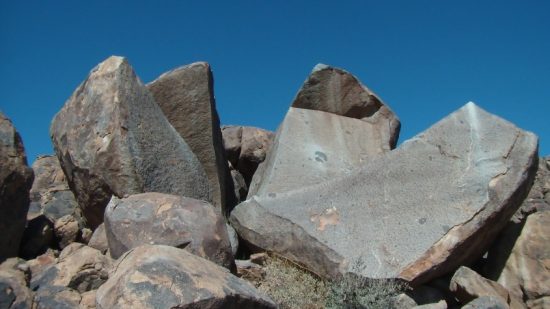
It’s the explosive blast – the Arc Blast – a sonic wave that blasts outward in all directions at the speed of sound like a wall of heavy air. It doesn’t move the air with it but rolls through it just the way an ocean swell rolls through water. It compresses and decompresses the air it moves through, instantly raising its temperature and pressure, then dropping it in the next instant.
There is another effect in the shock wave, called ionization. It’s the inevitable result of higher temperature and pressure, because, to put it in conventional terms, it means more atoms colliding, knocking electrons free.
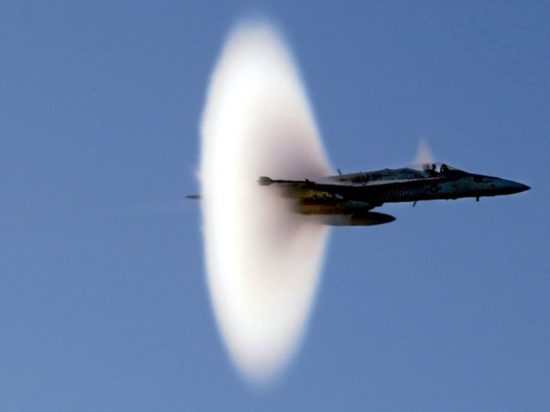
It’s really more than that, though. A shock wave generates current. The condensate in a cloud is an electric conductor. The dipolar molecule of water aligns with electric fields. Dipoles attract and drops form. Charge moves when this happens, meaning current. Current in a cloud is called “bound” current.
If you don’t believe me, question this: why do governments use electricity to modify weather? And how could they unless there is something in the cloud to carry current?
Here is a television news story from Fox 13 in Tampa Bay, Florida, broadcast July 27, 2021, which discusses how Dubai uses electricity to make rain. Watch below.
In other words, a shock wave is a plasma. It may be a weak plasma, like the sonic wave produced by a fighter jet that condenses water vapor, or it may be a sheet of electric current that spits lightning of its own, like the shock wave of a hydrogen bomb.
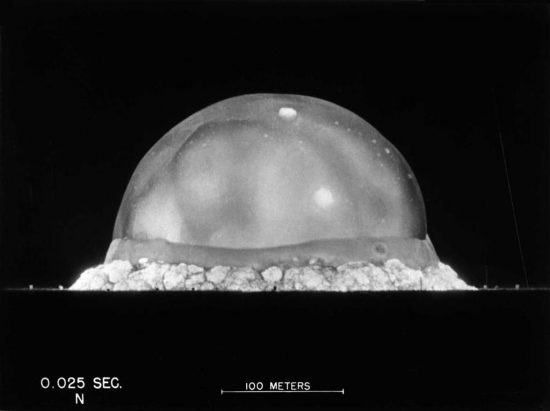
If you are fortunate enough to see a rocket launch or re-entry you may witness shock waves that are sufficiently ionized to glow in the upper atmosphere. For perspective, realize there are no shining ions traveling with the shock wave bubble. The bubble is moving through the air, ionizing and exciting atoms as it goes, generating a current in the shock wave. Shock waves are electric. The sight of glowing shock waves in the black of space is surreal. It gives you an idea of what the ancients saw in the sky.

Meteors also generate shock waves. The Chelyabinsk event produced a shock wave that injured many people. The Tunguska blast reportedly knocked people off their feet several miles away.
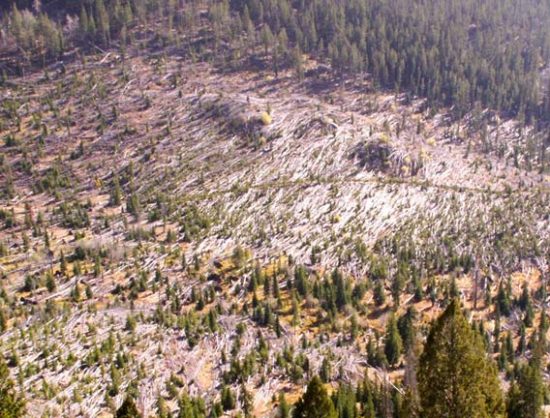
Now imagine a world in chaos, where winds shrieked at supersonic speeds. One need not ascribe to Velikovsky to imagine such a thing, because every mainstream theory of impact and accretion, or whatever is in favor today, would necessitate periods of chaotic atmosphere. Supersonic winds would have happened at times regardless of what science-based creation theory you ascribe to. Any big meteor impact would do it. Even the creationist’s seven days must have entailed some wind.
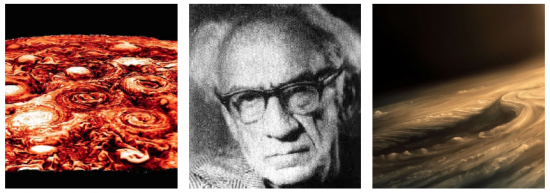
Besides that, we have planets in our Solar System with supersonic winds right now: Jupiter is one. To assume supersonic winds and shock waves occurred, and should therefore have left their mark on Earth, is perfectly sound logic in any cosmology.
Yet you don’t hear shock waves mentioned much by geologists. They make theories and wave their hands about tectonic forces without finding what does the pushing but they don’t say much about sonic shock waves. They use sonic waves as a tool, and they recognize micro-fractures in quartz, and shock cones in rocks due to meteor impacts, but virtually nothing about the winds that would result, or the effect of sonic shock waves.
Previous articles have shown that shock waves produced by supersonic winds left tetrahedral-shaped mountains with flat, triangular-faced mountain flanks. The evidence shows that Earth was embroiled, at times, in a maelstrom of winds that actually shaped the surface of the planet. The primary mechanism for the triangles you see so ubiquitously is a region of the shock wave called the Separation Bubble.
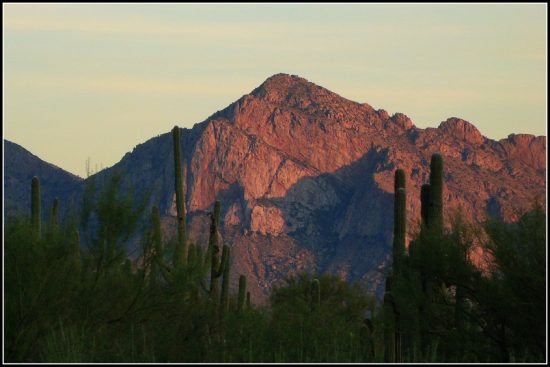
When a supersonic wind shears across a surface and meets an obstruction, it lifts to ride over the obstruction like a wing, because a high-pressure zone forms in front of the obstruction. This high-pressure zone is called the separation bubble, because it separates the supersonic flow from the ground, forcing it to change direction. Wind flow in the following diagrams is left to right unless noted otherwise.

It’s called a bubble because, in ideal conditions, it forms an actual tetrahedron-shaped bubble of high pressure, low-velocity air surrounded by low pressure, high-velocity air. The bubble walls or “membrane” are made of shearing and reflected shock waves. They are a predictable, inevitable, measurable boundary layer effect caused by the drag of supersonic wind over a surface.

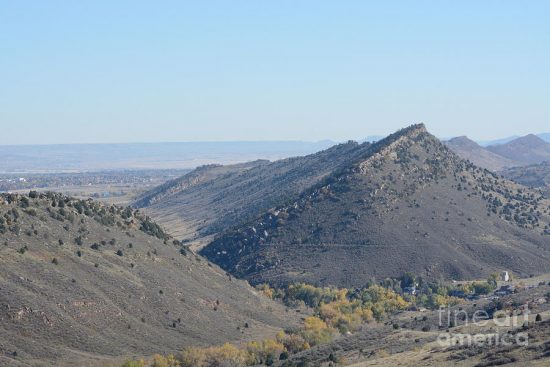
If you read my past articles on the subject, you’ll note I called the separation bubble a low pressure, low-velocity zone. That was a mistake. So this is meant to correct the record and give some more detail on them because they are the most tangible, accessible, reproducible, and compelling evidence for Velikovsky’s theories in existence.
I don’t say that lightly, but it’s absolutely true. Shock wave tetrahedrons are more abundant than rock art that can be compared to plasma instabilities. Comparisons of petroglyphs to simulated instabilities are simply shrugged off as pareidolia, anyway. They also don’t depend on interpretation of tiny points of light from a zillion miles away or guessing about the nuclear processes inside stars, or atoms. They don’t depend on reinterpreting mythology, equations, or the validity of anyone’s physics. Shock waves are well known by classical physics and applied science. Shock wave tetrahedrons cover our planet.
In fact, some aspects of plasma instabilities and astronomical “Z-pinch” nebula are due to shock waves. Some petroglyphs depict atmospheric shock waves, too. Sonic shock is essential science in the Electric Universe, and I’m confident Hannes Alfven would agree. In a plasma, shock waves and currents are coherent.
Shock waves generated during past cosmic upheaval on Earth interacted with solid ground and whatever matter they touched. They echoed from solid surfaces and shear zones. They vibrated and wobbled and crawled across the earth making piles of debris we call mountains. They interacted in patterns of constructive and destructive interference and resonated in harmonic frequencies. They left those patterns in the mountains for us to see. Shock waves are, after all, plasma sound waves. They are tangible, falsifiable, and accessible. They can be reproduced.
I’ve been noodling how to make a solid tetrahedron in a wind tunnel. The problem is getting adherence. If dry powders or sands are used, they won’t stick. If wet anything is used it will make a mess. Nature doesn’t care about messes and splatters stuff everywhere. But a wind tunnel is an expensive piece of equipment that doesn’t stand well to supersonic sandblasting.
Magnetic dust and magnet won’t work to adhere a tetrahedron, because the dust would take the shape of the magnet. I can’t get an ionized supersonic wind generator without a Chinese Electric Turbine, and so far the Chinese aren’t answering my calls. Neither is NASA. Funny, it’s the same phone number.
I think, maybe a big drop of glue, or epoxy could be used as the obstruction in a wind tunnel if it were performed while tacky. It should mold to the shock wave separation bubble without flying away. Anyway, it’s not an easy problem.
But wait, Nature provides proof. We don’t need a wind tunnel, the atmosphere itself is our laboratory. Iron meteors enter Earth’s atmosphere at supersonic speeds. Friction with the atmosphere melts and ablates the iron. Ablation patterns provide the proof of shock wave tetrahedrons.
Proof is in the Pudding
Figure 10, and several to follow, have molded iron shock tetrahedrons at the tips of flow patterns made by separation bubbles. This is tangible proof, made in conditions similar to theory. This piece of data is a start to prove science as we know it is mostly wrong. Well, okay, hugely wrong. Massively wrong. These meteorites should be prima facie evidence of Electric Earth Theory.
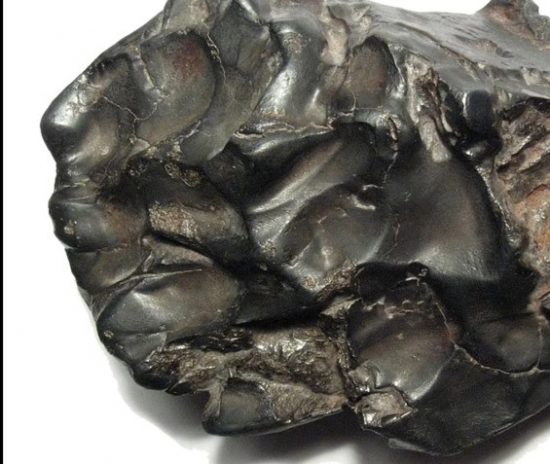
This is a meteor of iron with an ablated face caused by its supersonic entry into the atmosphere. Heat, pressure, and supersonic shock waves molded this face. The supersonic wind, impacting the meteor head-on, segregated into bubble-like pressure regimes. Low-pressure zones where wind velocity was greatest created scoops and divots. High-pressure zones segregated these air flows, leaving sharp dividing ridges, and triangular separation bubbles where the airflow separated from the meteor.
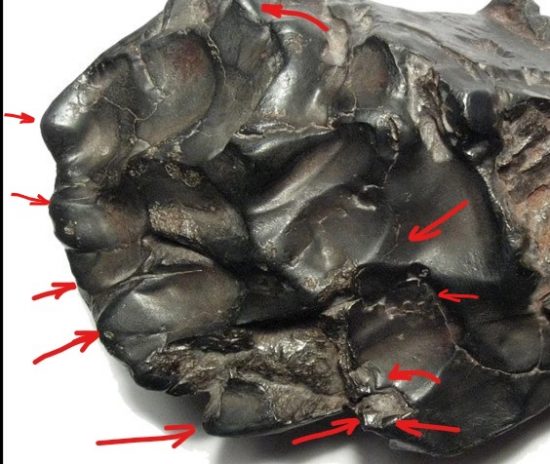
The smooth divots are impressions of flow streams, and the triangles appear at their tips. The change in direction as airflow separated from the object created separation bubbles, which molded the fluid iron. Molten iron was pushed from the divot like pudding, and held in the high-pressure separation bubble, molding it to the form of the bubble. Look closely and you will find where some tips broke off.
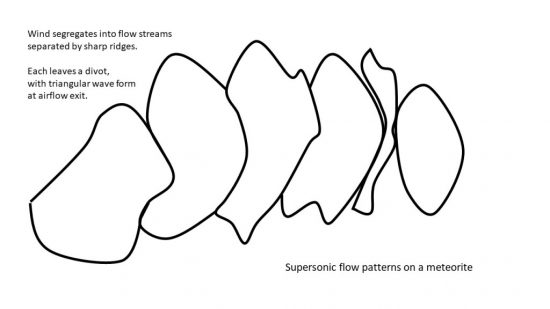
The entire divot is, in effect, the separation bubble. It is literally bubbles, formed with skin effect from shock waves that hold tension like a bubble’s film. It creates “Y” shaped structures around a “triple point” where shock waves and bubbles meet, sometimes called the “Lambda Structure.”

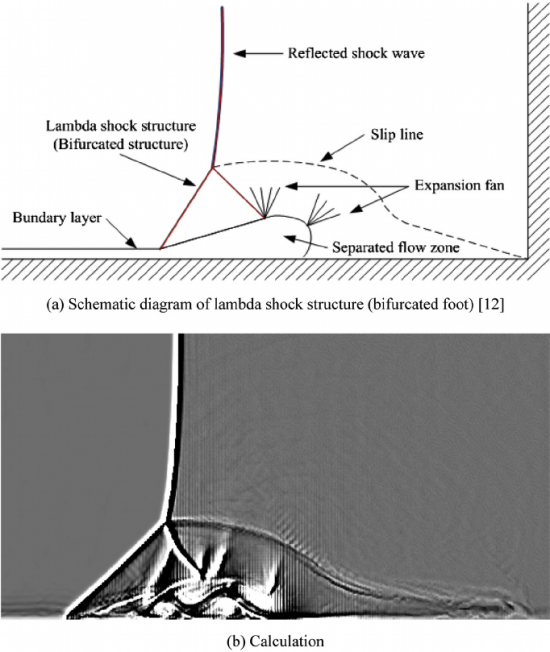
In the case of mountain building, winds laden with dust passed into the bubble, and were heated, compressed, and slowed to a stop passing through the shock wave. The ground was statically charged and adhered the dust, mud, sand, stuff falling from outer space, or whatever the wind carried. Hence the dust piled in the shape of the bubble – a tetrahedron.
Take a look at the similarity in these tetrahedrons formed by a hot blast of air in South America to the ones along the edge of the meteorite.
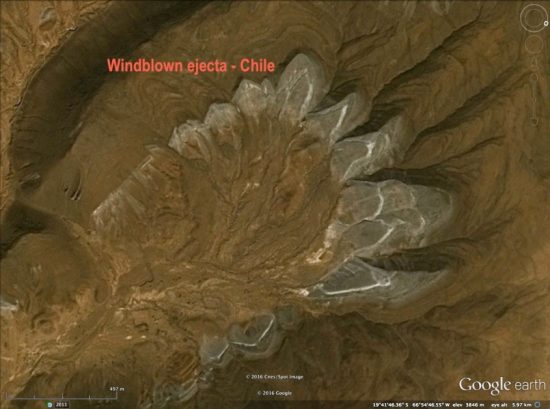
Really, it can’t be more obvious. In Figure 14, it’s visually apparent how a non-rotating, down-burst wind layered the dust in a consistent pattern of tetrahedrons formed by separation bubbles where the wind impacted and deflected from the land. This was made by a blow-torch aimed at the ground – the hot exhaust of a mesocyclone that churned in a plasma storm of Jovian proportions.
The side of the tetrahedron facing the wind will be a perfect isosceles triangle if the wind strikes normal to the object. If the wind hits obliquely, is interfered with by adjacent shock waves, is sub-sonic, or transient in its velocity, or if the dust load deposited doesn’t fill the entire separation bubble, it will deform the tetrahedron.
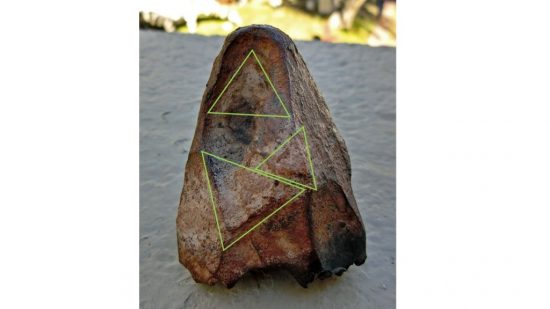
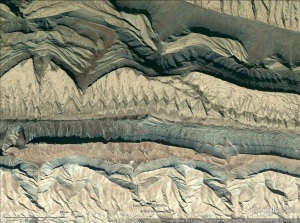
You are not suffering from pareidolia. A triangle is a triangle, and that is what you are seeing. We could be scientific and take measurements to prove these are triangles, but I think we can use common sense. Here are more examples of tetrahedrons formed on iron meteorites.
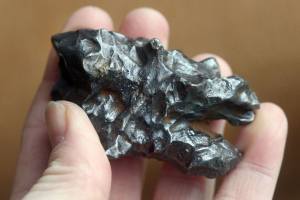

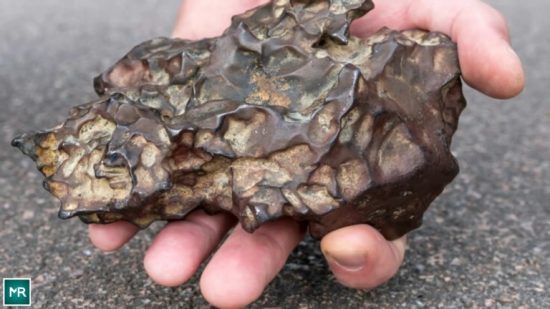
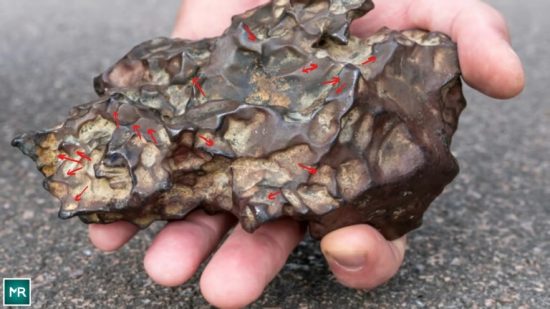
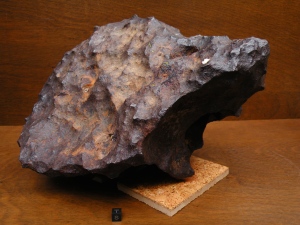
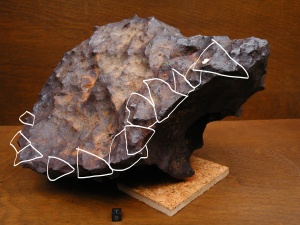
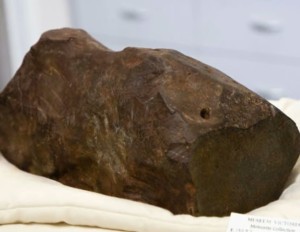
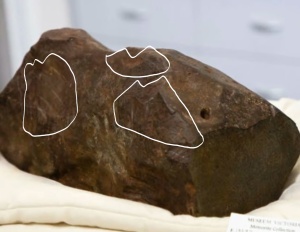
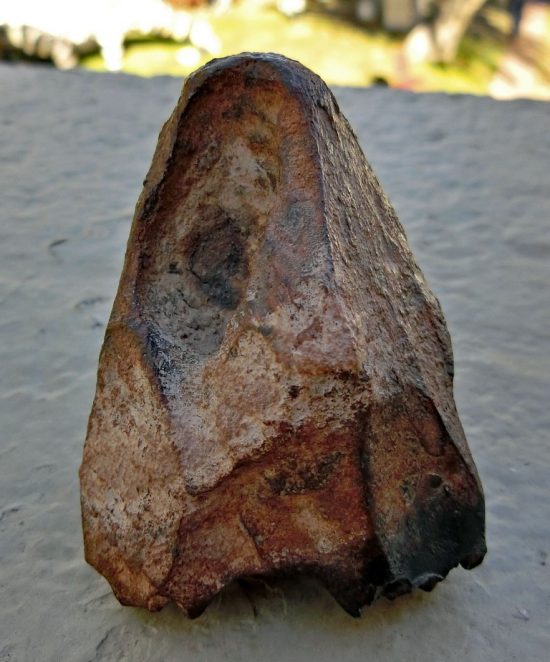
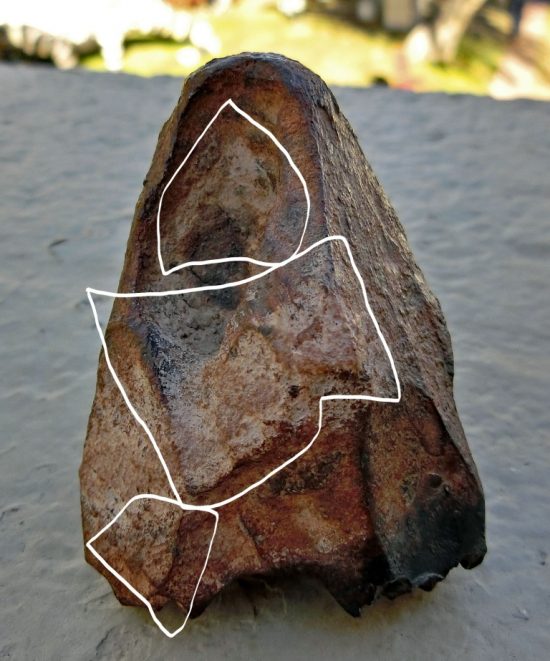
The size of the separation bubble depends on the size of the object because that determines the area of wind moving past the object and therefore the size of the shock wave. So, the bigger the meteor, the bigger the tetrahedrons.
The constituency of the rock also affects the roughness of the surface, whether it is chunky, or smooth, as they say. Regardless of many variables, the triangular face of separation bubbles are distinct and appear exactly where they should if one traces the wind patterns. Jeez, somebody out there must have noticed this before. I’ll bet there is some obscure, mustachioed PhD at the Upper-Siberian Institute of Aerodynamic Widgets who knows all about this. Please call me.
In a completely different circumstance, lightning-generated shock waves also produce tetrahedrons. The next four figures are photos of an iron-bearing rock that has been struck by lightning, partly melted and vitrified, with raised triangular layers where fluid metal was trapped by separation bubbles.
The lightning left a yellowed, chemically altered trail where it surface-conducted to a shoe-shaped pool where the rock melted. The arc likely met some discontinuity, or crack in the rock where it burrowed in, creating a hot spot. Cutting beneath the skin of the rock created an arc flash that trapped triangular sheets of molten rock in the separation bubbles, pointed outward from the center of the blast, shown in the following images.
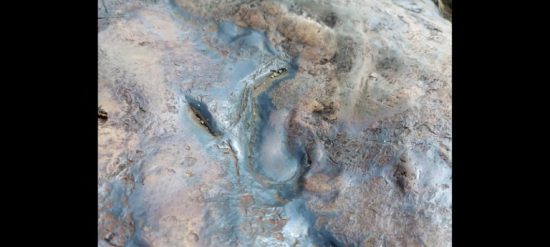
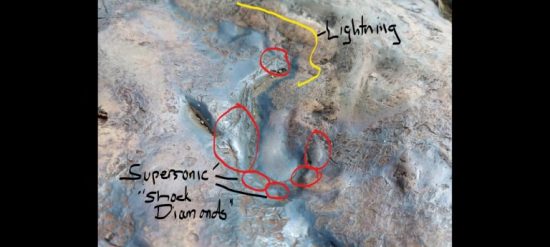
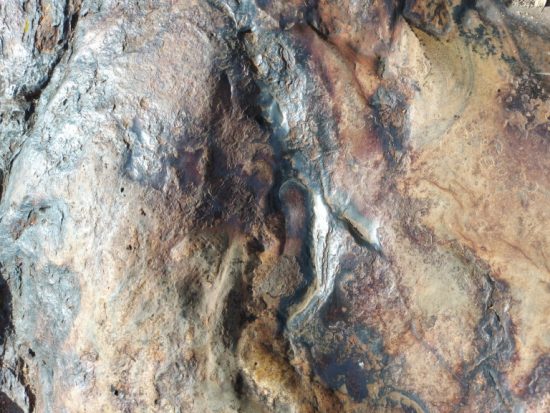
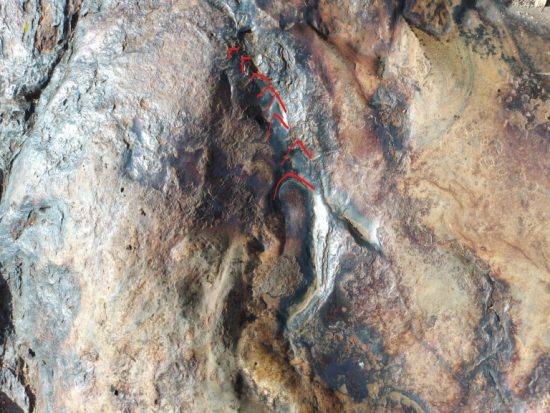
The final image shows a track of very small triangles marching out of the molten puddle. The amplitude of the triangle is related to the cross-section of wind that created it. What this little trail of arrowheads means is that a very narrow supersonic jet stream blasted this channel in the rock, and you can see exactly the path it took.
Can you find any other tetrahedrons surrounding the track outlined? They are aimed perpendicular to the narrow track and larger amplitude. I counted six good-sized ones, but there are a bunch of small ones, too. The arc channeled a narrow, focused jet, while at the same time, shock waves blasted outward in a diffuse wave that produced larger amplitudes. There is also a second lightning track from the bottom right corner. There are shock patterns that correlate with the blast from each lightning track.
For global-scale winds, separation bubbles became quite large. Figure 17 gives you some idea of scale. The separation bubble that creates a mountain is just the very foot of a shock wave structure much more complex than a simple tetrahedron. There are flow paths in, around, and behind the separation bubble that all leave their mark on the ground.
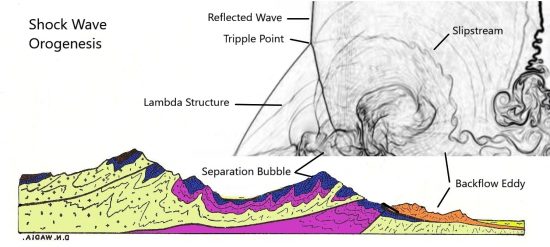
If the wind keeps blowing dust at supersonic speed, the tetrahedron formed in the separation bubble blocks the air, forming a new obstruction to the wind, and a new separation bubble forms in front of it, trapping more dust that layers in the triangular shape of its windward face. This blankets the tetrahedron face with layer after layer of deposit with each pulse of the wind. Each pulse of the wind may carry different constituents of dust and charge, so each layer deposited has its own characteristic chemistry.
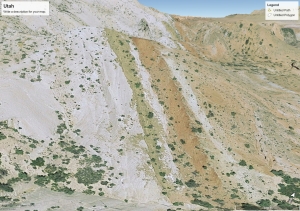
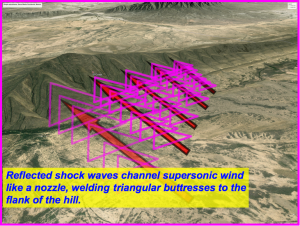
It is exactly the same way wind makes sand dunes, except supersonic shock waves are rigid and straight and make sharp angles instead of soft curves. Sand dunes are formed in the high pressure, low-speed zones beneath an undulating wind, and the troughs are low pressure, high-speed zones. The high-speed winds carry the sand to the low-speed zones. That is why they appear in waves. Static electricity plays a role in sand dunes, too, lofting and adhering the sand, and so it does with shock waves.
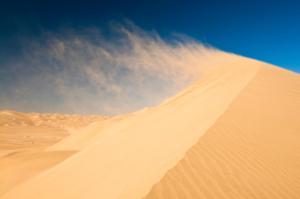
Each layer’s chemistry reacted with adjacent layers. The matter laid down still swam with free charge. Migrations and recombination focused at the layer interfaces, still hissing and vibrating with shock wave echoes, where dissimilar matter made reactions, drawing ions from surroundings. Charge built an electric field across these interfaces, in the way a capacitor makes an electric field. Seams became hardened and mineralized, and sometimes evacuated by gases evolved from reactions that channeled caverns as they expanded.
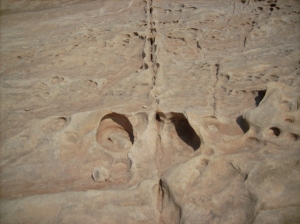
The electric field, transverse to the seam, is why most quartz veins grow transverse across rock seams. They are the electrical expressions left by shock waves and electric fields. The consensus theory of hydrolyzed silica migrating into rock seams by hydrothermal action isn’t entirely wrong, but it misses the role of electricity and how it would accelerate the pace of crystal formation. It also misses the role electricity plays in the migration of conductive metals into quartz veins and a number of other things.
Shock waves took different polarities. They generated lightning. They connected ground to cloud in a sheet of plasma current. They ionized air, water vapor, and dust. They melted metals. They vibrated and electrified the ground. They segregated airborne matter by electrostatic filtration. They compressed matter in geometric shapes and charged it with current to fuse it together. They formed plasma networks of active circuitry. They patterned the wind in diamonds that glowed, with sparks shooting through. They turned biological beings to jelly.
Shock waves are a pathway for discharge, a current generator, and a capacitor across the walls of shock “membranes.” They are a big piece of Earth’s circuitry and a principle action of Nature. They are the most obvious, prolific, and easily defined proof that Earth was formed, and still performs as an electrical body.
And one of the most beautiful. After all, they produced these:
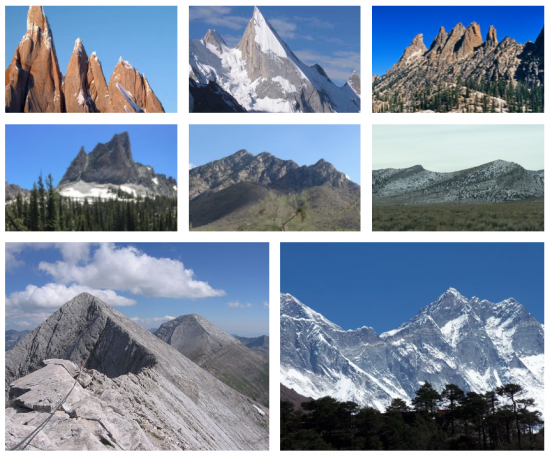
We’ve been looking at the triangular face of the tetrahedron. The focus will turn to the rear end, and the crack between bubbles, in the next article.
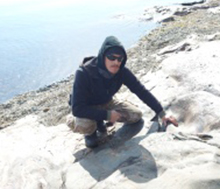
Special thanks to Stefan Ahmala, who took the photos of the rocks in Finland. Stefan discovered Thunderbolts recently, and like most of us, arrived here because he knew the rest of the world is crazy. Stefan is very enthusiastic, and immediately recognized these rocks for what they are and contacted us. Wouldn’t you know I was writing an article on tetrahedrons when his photos arrived?
Additional Resources by Andrew Hall:
Surface Conductive Faults | Thunderblog
Arc Blast — Part One | Thunderblog
Arc Blast — Part Two | Thunderblog
Arc Blast — Part Three | Thunderblog
The Maars of Pinacate, Part One | Thunderblog
The Maars of Pinacate, Part Two | Thunderblog
Nature’s Electrode | Thunderblog
The Summer Thermopile | Thunderblog
Tornado — The Electric Model | Thunderblog
Lightning-Scarred Earth, Part 1 | Thunderblog
Lightning-Scarred Earth, Part 2 | Thunderblog
Sputtering Canyons, Part 1 | Thunderblog
Sputtering Canyons, Part 2 | Thunderblog
Sputtering Canyons, Part 3 | Thunderblog
Eye of the Storm, Part 1 | Thunderblog
Eye of the Storm, Part 2 | Thunderblog
Eye of the Storm, Part 3 | Thunderblog
Eye of the Storm, Part 4 | Thunderblog
Eye of the Storm, Part 5 | Thunderblog
Eye of the Storm, Part 6 | Thunderblog
Eye of the Storm, Part 7 | Thunderblog
Eye of the Storm, Part 8 | Thunderblog
Eye of the Storm, Part 9 | Thunderblog
Eye of the Storm, Part 10 | Thunderblog
Laramie Mountains, Part 1 | Thunderblog
Laramie Mountains, Part 2 | Thunderblog
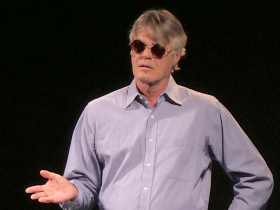
Andrew Hall is a natural philosopher, engineer, and author. A graduate of the University of Arizona’s Aerospace and Mechanical Engineering College, he spent thirty years in the energy industry. He has designed, consulted, managed, and directed the construction and operation of over two and a half gigawatts of power generation and transmission, including solar, gasification, and natural gas power systems. From his home in Arizona, he explores the mountains, canyons, volcanoes, and deserts of the American Southwest to understand and rewrite an interpretation of Earth’s form in its proper electrical context. Andrew was a speaker at EU2016, EU2017 and the EUUK2019 conferences. He can be reached at hallad1257@gmail.com or thedailyplasma.blog
Disclosure: The proposed theories are the sole ideas of the author, as a result of observation, experience in shock and hydrodynamic effects, and deductive reasoning. The author makes no claims that this method is the only way mountains or other geological features are created.
Ideas and/or concepts presented in Thunderblogs do not necessarily express or represent the Electric Universe model or the views of The Thunderbolts Project or T-Bolts Group Inc.












